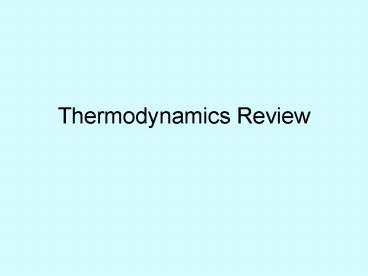Thermodynamics Review PowerPoint PPT Presentation
1 / 10
Title: Thermodynamics Review
1
Thermodynamics Review
2
Definitions
Extensive and Intensive Properties Subdivide a
system into parts. An extensive property is one
whose value is the sum of the values of the
parts (mass, volume, kinetic energy). Intensive
properties are pressure temperature. Adiabatic
process Any process with no heat interaction
(interaction due to a temp difference bet. 2
systems). Isolated system No interactions with
other systems Entropy Property of matter that
measures the degree of disorder at
the Microscopic level. The notion that entropy
can be produced, but never destroyed, is the
Second Law of thermodynamics. Entropy changes can
be quantified using the Gibbs equation (recall, G
H-TS)
3
The First Law of Thermodynamics(Conservation of
Energy)
Sadi Carnot (early 1800s, France) Tidbit
Father was Napoleon's minister of war (1799).
If one has a systems and puts heat into it, and
does work on it, then its energy increases by
the amount of heat put in and work done.
Change in U Q W
Work done on the system
Increase in Energy U of the system
Heat, Q, put into the system
? U ? Q ? W
Differential form
4
First Law for a Control Mass System
- Sometimes written as dE ?Q ?W
- where E is the energy of the system U PE KE
- dE dUd(KE)d(PE)
- For now, lets assume d(KE) d(PE) 0
Adiabatic (?Q 0) - ?dE dU ?W -(PdVVdP) for a simple
compressible substance - If Pconstant (dP 0), then dU PdVVdP 0
- --gt dH 0 (HUPV enthalpy)
Hreactants Hproducts
5
First Law for a Control Mass System
Define hH/M where M is mass constant for
a fixed control mass
Hreactants Hproducts
Hreactants/Mreactants Hproducts /Mproducts
? hreactants hproducts for constant pressure
process
For constant volume process (dV 0)
dU(PdVVdP) VdP or dH VdP -gt H-VPconstant
-gt h-vPconstant Thus, (h-vP)reactants(h-vP)prod
ucts at constant V
6
Basic Laws
Eqn (2.3)
First Law
Heat transferred to the system in going from
state 1 to 2
Work done by the system in going from state 1 to 2
u is the internal energy
is the change in kinetic energy between states
is the change in potential energy between states
7
Basic Laws
For steady flow through a CV, one stream entering
and one leaving, And neglecting PE changes
Eqn (2.4)
8
Equation of State
Specify 2 independent properties will fix the
state of a system (e.g., P-v-T plot f(P,v,T)0
is called the thermal equation of state) Ideal
Gas pvnRT
Energy Equation of State u u(P/T) uenergy
per unit mass can also be written as uu(P,v)
or uu(T,v)
From these known values (P,T, v, u) all other
thermo properties can be determined
9
Other Necessary Definitions
Specific heat at constant volume Specific heat
at constant pressure Ratio of the specific
heats
cp-cv R
8.314x103J/(kmol K)
10
Continuity Equation
(2.8)
One-dimensional form
mass flow rate cross sectional area average
velocity across section specific volume of fluid
(volume/mass1/?)

